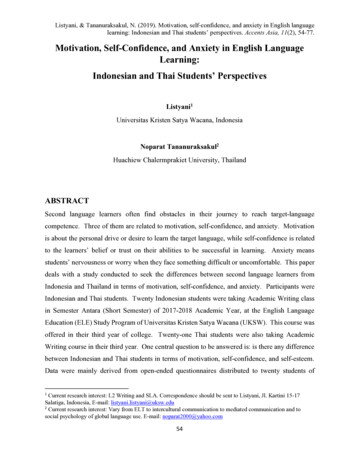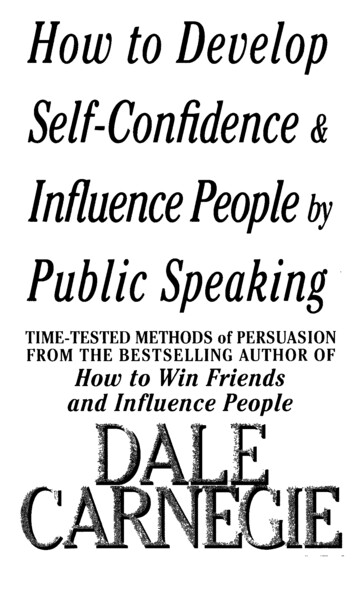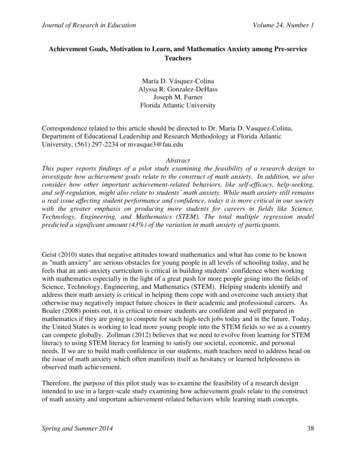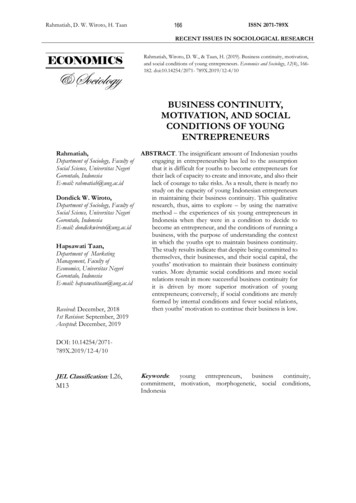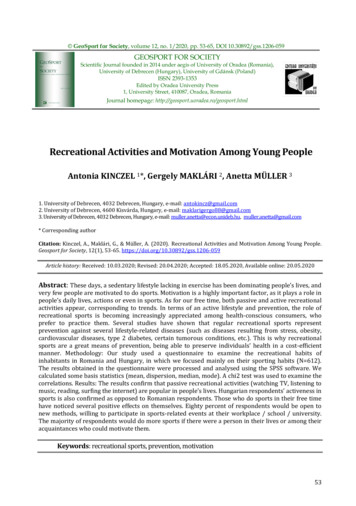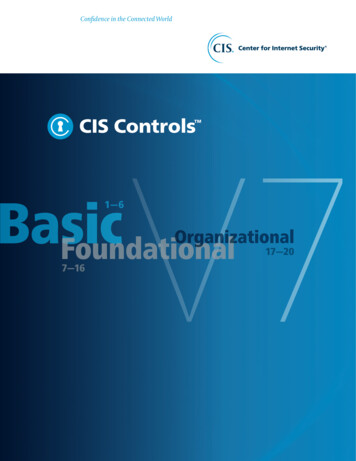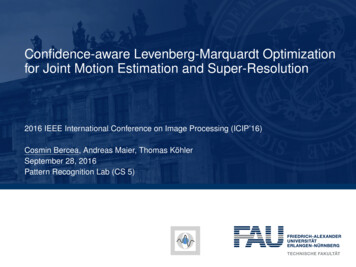
Transcription
SELF-CONFIDENCEANDPERSONAL MOTIVATIONRoland Bénabou and Jean Tirole1First version: June 1999This version: June 20011This paper was previously entitled “Self-Confidence: Intrapersonal Strategies.” We are grateful for helpful comments and discussions to Dilip Abreu, Olivier Blanchard, Isabelle Brocas, Ed Glaeser, Dan Gilbert, IanJewitt, David Laibson, George Loewenstein, Andrew Postlewaite, Marek Pycia, Matt Rabin, Julio Rotemberg and three anonymous referees, as well as conference and seminar participants at Chicago, Columbia,Cornell, MIT, the NBER, Northwestern, NYU, the Oxford Young Economists’ Conference, the University ofPennsylvania, Princeton, Stanford, and Yale. Bénabou gratefully acknowledges financial support from theNational Science Foundation (SES—0096431).
SELF-CONFIDENCE AND PERSONAL MOTIVATIONRoland Bénabou and Jean Tirole1ABSTRACTWe analyze the value placed by rational agents on self—confidence, and the strategies employedin its pursuit. Confidence in one’s abilities generally enhances motivation, making it a valuableasset for individuals with imperfect willpower. This demand for self—serving beliefs (which canalso arise fromhedonic or signalling motives) must be weighed against the risks of overconfidence.On the supply side, we develop a model of self-deception through endogenous memory that reconciles the motivated and rational features of human cognition. The resulting intrapersonal gameof strategic communication typically leads to multiple equilibria. While “positive thinking” canimprove welfare, it can also be self-defeating (and nonetheless pursued).1This paper was previously entitled “Self-Confidence: Intrapersonal Strategies.” We are grateful for helpfulcomments and discussions to Dilip Abreu, Olivier Blanchard, Isabelle Brocas, Ed Glaeser, Dan Gilbert, Ian Jewitt,David Laibson, George Loewenstein, Andrew Postlewaite, Marek Pycia, Matt Rabin, Julio Rotemberg and threeanonymous referees, as well as conference and seminar participants at Chicago, Columbia, Cornell, MIT, the NBER,Northwestern, NYU, the Oxford Young Economists’ Conference, the University of Pennsylvania, Princeton, Stanford,and Yale. Bénabou gratefully acknowledges financial support from the National Science Foundation (SES—0096431).0
“Believe what is in the line of your needs, for only by such belief is the need fulfilled.Have faith that you can successfully make it, and your feet are nerved to its accomplishment”.William James, Principles of Psychology.“I have done this, says my memory. I cannot have done that, says my pride, remaininginexorable. Finally—memory yields.”Friedrich Nietzsche, Jenseits von Gut und Böse.“I had during many years followed the Golden Rule, namely, that whenever a publishedfact, a new observation or thought came across me, which was opposed to my generalresults, to make a memorandum of it without fail and at once; for I had found byexperience that such (contrary and thus unwelcome) facts and thoughts were far moreapt to escape from memory than favorable ones.”Charles Darwin. The Life of Charles Darwin, by Francis Darwin.IntroductionThe maintenance and enhancement of self-esteem has always been identified as a fundamentalhuman impulse. Philosophers, writers, educators and of course psychologists all have emphasizedthe crucial role played by self-image in motivation, affect, and social interactions. The aim ofthis paper is to bring these concerns into the realm of economic analysis, and show that this hasimportant implications for how agents process information and make decisions. Conversely, thetools of economic modelling can help shed light on a number of apparently irrational behaviorsdocumented by psychologists.Indeed, both the demand and the supply sides of self—confidence appear at odds with economists’view of human behavior and cognition. Why should people prefer rosy views of themselves toaccurate ones, or want to impart such beliefs to their children? From car accidents, failed dot.comfirms and day trading to the space shuttle disaster and lost wars, the costs of overconfidence areplain for all to see. Even granting that some “positive illusions” could be desirable, is it evenpossible for a rational, Bayesian individual to deceive himself into holding them? Finally, thewelfare consequences of so-called self—serving beliefs are far from clear: while “thinking positive”is often viewed as a good thing, self—deception is not, even though the former is only a particularform of the latter.To analyze these issues we develop in this paper a simple formal framework that unifies a numberof themes from the psychology literature, and brings to light some of their economic implications.We first consider the demand side of self-confidence, and identify in Section I three main reasons whypeople may prefer optimistic self-views to accurate ones: a consumption value, a signalling value,1
and a motivation value. First, people may just derive utility from thinking well of themselves, andconversely find a poor self-image painful. Second, believing —rightly or wrongly— that one possessescertain qualities may make it easier to convince others of it. Finally, confidence in his abilities andefficacy can help the individual undertake more ambitious goals and persist in the face of adversity.While we shall mostly focus on this last explanation, all three should be seen as complementary,and for many purposes work equally well with the supply—side of our model (self—deception).The main reason why we emphasize the motivation theory is its substantially broader explanatory power. Indeed, it yields an endogenous value of self—confidence that responds to the situationsand incentives which the individual faces, in a way that can account for both “can-do” optimismand “defensive” pessimism. It also readily extends to economic and social interactions (altruisticor not), explaining why people generally prefer self—confident partners to self—doubting ones, andinvest both time and effort in supporting the latter’s morale.The first premise of the motivation theory is that people have imperfect knowledge of theirown abilities, or more generally of the eventual costs and payoffs of their actions.2The secondone is that ability and effort interact in determining performance; in most instances they arecomplements, so that a higher self-confidence enhances the motivation to act. As demonstrated bythe opening quote from James [1890], this complementarity has long been familiar in psychology.3It is also consistent with the standard observation that morale plays a key role in difficult endeavors;conversely, when people expect to fail they fail quite effectively, and failure leads to failure morereadily for individuals characterized with low self-esteem (Salancik [1977]).The fact that a higher self-confidence enhances the individual’s motivation gives anyone witha vested interest in his performance an incentive to build up and maintain his self-esteem. First,the manipulator could be another person (parent, teacher, spouse, friend, colleague, manager)who is eager to see him “get his act together”, or otherwise apply himself to the task at hand.Such interpersonal strategies are studied in Bénabou and Tirole [2000]. Second, for an individualsuffering from time inconsistency (e.g., hyperbolic discounting), the current self has a vested interestin the self-confidence of future selves, as it helps counter their natural tendency to quit too easily. Itis in this context, which builds on Carrillo and Mariotti [2000], that we shall the investigate a varietyof intrapersonal strategies of self—esteem maintenance. We shall thus see how and when peoplemay choose to remain ignorant about their own abilities, and why they sometimes deliberatelyimpair their own performance or choose overambitious tasks in which they are sure to fail (self2The psychology literature generally views introspection as quite inaccurate (Nisbett and Wilson [1977]), andstresses that learning about oneself is an ongoing process. Furthermore, the self is constantly changing (e.g., Rhodenwalt [1986]): personal characteristics evolve with age, the goals pursued shift over one’s career and life cycle (oftenas the result of interactions with others), and the personal or economic environment in which these objectives arerewarded are pursued is typically variable.3Thus, Gilbert and Cooper [1985] note that “the classic attributional model of the causes of behavior . [isdescribed by] the well-known conceptual equation: (E A) T D B, in which effort times ability, plus or minustask difficulty equals the behavioral outcome.” Additional references are given in Section I. Note, however, that thereare also instances where ability and effort are substitutes. As discussed below, we shall consider this case as well.2
handicapping).Section II thus turns to the supply side of the self—confidence problem, and the “reality constraints” that limit the extent to which people can engage in wishful thinking. In our model wemaintain the standard assumption of individuals as rational (Bayesian) information processors.While almost universal in economics, this view is more controversial in psychology. On one hand, alot of the classical literature has emphasized rationality and information-seeking in the process ofself-identification, documenting the ways in which people update their beliefs according to broadlyBayesian principles.4 On the other hand, the more recent cognitive literature abundantly documents the less rational (or at least, motivated) side of human inference.For instance, a substantial body of evidence suggests that people tend to recall their successesmore than their failures, and have self-servingly biased recollections and interpretations of their pastperformances.5 Similarly, they tend to overestimate their abilities and other desirable traits, as wellas the extent to which they have control over outcomes. They also rate their own probabilities asabove average for favorable future life events, and below average for unfavorable ones; the morecontrollable these events through their future actions, the more so.6We shall capture this class of self-deception phenomena with a simple game—theoretic model ofendogenous memory, or awareness-management, which represents one of the main contributions ofthis paper. Drawing on evidence about the mechanics and limitations of memory, it shows howto reconcile the motivated (“hot”) and rational (“cold”) features of human cognition, and couldbe used in any setting where a demand for motivated beliefs arises. The basic idea is that theindividual can, within limits and possibly at a cost, affect the probability of remembering a givenpiece of data. At the same time, we maintain rational inference, so people realize (at least to someextent) that they have a selective memory or attention.The resulting structure is that of a game of strategic communication between the individual’stemporal selves. In deciding whether to try and repress bad news, the individual weighs the benefits from preserving his effort motivation against the risk of becoming overconfident. Later on,however, he appropriately discounts the reliability of rosy recollections and rationalizations. Theimplications of this game of asymmetric information are quite different from those of ex—ante de4Thus attribution theory (Heider [1958] emphasizes the distinction between temporary (situational) and enduring(dispositional) characteristics. In economics parlance, the individual filters out noise in order to extract informationfrom past events. In the social comparison process (Festinger [1954]), individuals assess their ability by comparingtheir performance with that of people facing similar conditions (familial, cultural, educational, etc.,). In other words,they use “relative performance evaluation”, or “benchmarking”, for self-evaluation. A good performance by othersin one’s reference group is thus generally detrimental to self-esteem, and conversely some comfort is derived whenothers experience adversity (Schadenfreude). Relatively sophisticated updating also applies to the interpretation ofpraise and criticism: a person takes into account not only what others say (or do), but also their possible intentions.5Why they would want to do so in a social context is obvious. The interesting question is why they may bias theirown inference process.6See, e.g. Taylor and Brown [1988]). Weinstein [1980], Alloy and Abrahamson [1979], and the many otherreferences given in Section II. For recent overviews of the general phenomenon of self-deception, see Gilbert andCooper [1985] and especially Baumeister [1998] on the psychological evidence, Elster [1999] and Mele [1999] for thephilosophical debates and implications.3
cisions about information acquisition (e.g., self—handicapping or selective search). In particular,multiple intrapersonal equilibria (“self—traps”) may arise, ranging from systematic denial to complete self-honesty. More generally, we characterize the set of Bayesian perfect equilibria and itsdependence on the individual’s degree of time inconsistency and repression costs (“demand andsupply” parameters).The model also has interesting implications for the distribution of optimism and pessimismacross agents, which we examine in Section III. We show that when the costs of repression are lowenough, most people typically believe themselves to be more able than they actually are, as wellas more able than both the average and the median of the population. A minority will have eitherrealistically low assessments, or actually severely underestimate themselves. We also highlightthe key role played by Bayesian—like introspection (understanding, at least partially, one’s ownincentives for self—esteem maintenance) in the model’s results, and why incorporating this essentialhuman trait is more fruitful than modelling agents as naively taking all recollections and self—justifications at face value.Section IV examines the wel
The maintenance and enhancement of self-esteem has always been identi fied as a fundamental human impulse. Philosophers, writers, educators and of course psychologists all have emphasized the crucial role played by self-image in motivation, affect, and social interactions. The aim of this paper is to bring these concerns into the realm of economic analysis, and show that this has important .
